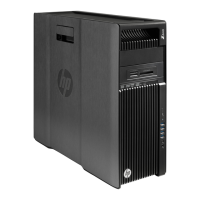2
Technical white paper | HP Z640 Workstation
Chassis and system highlights
More power! More performance! HP is excited to introduce the Z640 Workstation.
This surprisingly small workstation has been optimized to provide maximum
performance in minimal space. The HP Z640 continues to oer a convenient tool-free
design, amazingly quiet acoustics, and impressive expandability for its product size.
Mobility and exibility
Our customers continue to express the need for easy system mobility. Like its predecessor, the HP Z640 has full-grip
integrated carrying handles and one can easily slide the system around on a variety of surfaces. In addition, a convenient
landing pad has been integrated into the top surface of the workstation for storing accessories such as a mobile phone
being charged by the front USB 3.0 charging port.
The exible HP Z640 design allows for the system to be used in the tower orientation or rack-mounted with enterprise-
class rails. To oer additional exibility in deployment, the HP Z640 is modular by design allowing it to be congured
as a single or dual processor system. The optional 2nd processor module provides the second CPU and four additional
memory slots—providing a total of eight DIMM slots for this very compact dual processor workstation! Adding or
upgrading memory on the 2nd processor module is extremely easy—no tools required and it takes only seconds to
remove and install, featuring intuitive touchpoints and handles, user-friendly positive latching, self-aligning guides, and
blind-mate (no cable) interconnections.
With two internal storage bays, two standard 5.25" external device bays, a dedicated 9.5mm slim ODD bay, three PCIe
Gen3 slots (1x8 and 2x16), two PCIe Gen 2 slots (1x4 and 1x1), along with a single PCI slot the HP Z640 delivers exibility
for storage and accessory options. The Internal storage bays feature tool-free drive trays which are compatible with
industry standard 3.5" storage devices or 2.5" devices with the appropriate carrier. The HP Z640 also provides tool-free
accessibility to the external device bays—expanding storage capabilities or allowing additional I/O options as needed
with just a few simple steps.
Interior design
The streamlined interior is well organized and all user serviceable components are identied with consistent green
touchpoints. Cables are hidden or eciently routed, providing better component access and airow management.

